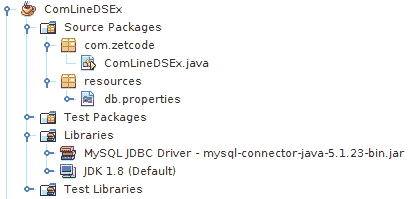Java 中的数据源
原文:http://zetcode.com/java/datasource/
在本教程中,我们学习如何在 Java 中设置数据源。 我们使用 MySQL 数据库系统。 ZetCode 拥有用于 MySQL Java 的完整电子书: MySQL Java 编程电子书。
我们使用 MySQL Connector/J 驱动程序。 它是 MySQL 的官方 JDBC 驱动程序。
用 Java 创建到数据库的连接有两种基本方法:a)使用驱动程序管理器,b)使用数据源。 与驱动程序管理器相比,数据源具有几个优点:
- 它支持分布式事务
- 它提供了一种连接池技术
- 它可以由服务器(即应用外部)进行管理
当在 Java 类中创建和关闭连接时,驱动程序管理器会影响应用性能。 驱动程序管理器可用于简单的测试应用中。 对于复杂的应用,始终建议使用数据源。 请参阅 MySQL Java 教程,以了解如何在 Java 应用中使用驱动程序管理器。
通常,将基于 Java 命名和目录接口(JNDI)API 向实现数据源接口的对象注册命名服务。
JDBC
JDBC 是 Java 编程语言的 API,用于定义客户端如何访问数据库。 它提供了查询和更新数据库中数据的方法。 JDBC 面向关系数据库。 从技术角度来看,API 是java.sql包中的一组类。 要将 JDBC 与特定数据库一起使用,我们需要该数据库的 JDBC 驱动程序。
MySQL
MySQL 是领先的开源数据库管理系统。 它是一个多用户,多线程的数据库管理系统。 MySQL 在网络上特别流行。 MySQL 有两个版本:MySQL 服务器系统和 MySQL 嵌入式系统。
mysql> CREATE DATABASE testdb;
Query OK, 1 row affected (0.02 sec)
我们创建一个新的testdb数据库。 在本教程中,我们只需要一个数据库对象。 我们将不使用表格。 我们将使用SELECT VERSION()语句获取 MySQL 数据库的版本。
命令行应用
在此示例中,我们使用命令行 Java 应用连接到数据库。

图:项目结构
这就是 NetBeans 中项目结构的样子。
MysqlDataSource是用于创建数据源的类。
db.properties
# mysql properties
mysql.driver=com.mysql.jdbc.Driver
mysql.url=jdbc:mysql://localhost:3306/testdb
mysql.username=testuser
mysql.password=test623
这些是 MySQL 数据库的属性。 db.properties文件位于此项目的src/resources子目录中。
ComLineDSEx.java
package com.zetcode;
import com.mysql.jdbc.jdbc2.optional.MysqlConnectionPoolDataSource;
import com.mysql.jdbc.jdbc2.optional.MysqlDataSource;
import java.io.FileInputStream;
import java.io.FileNotFoundException;
import java.io.IOException;
import java.sql.Connection;
import java.sql.ResultSet;
import java.sql.SQLException;
import java.sql.PreparedStatement;
import java.util.Properties;
public class ComLineDSEx {
public static MysqlDataSource getMySQLDataSource() throws
FileNotFoundException, IOException {
Properties props = new Properties();
FileInputStream fis = null;
MysqlDataSource ds = null;
fis = new FileInputStream("src/resources/db.properties");
props.load(fis);
ds = new MysqlConnectionPoolDataSource();
ds.setURL(props.getProperty("mysql.url"));
ds.setUser(props.getProperty("mysql.username"));
ds.setPassword(props.getProperty("mysql.password"));
return ds;
}
public static void main(String[] args) throws IOException, SQLException {
Connection con = null;
PreparedStatement pst = null;
ResultSet rs = null;
MysqlDataSource ds = getMySQLDataSource();
try {
con = ds.getConnection();
pst = con.prepareStatement("SELECT VERSION()");
rs = pst.executeQuery();
if (rs.next()) {
String version = rs.getString(1);
System.out.println(version);
}
} finally {
if (rs != null) {
rs.close();
}
if (pst != null) {
pst.close();
}
if (con != null) {
con.close();
}
}
}
}
在此示例中,我们使用数据源连接到数据库并获取 MySQL 的版本。
fis = new FileInputStream("src/main/Resources/db.properties");
props.load(fis);
从具有FileInputStream类的db.properties文件中读取数据库属性。
ds = new MysqlConnectionPoolDataSource();
ds.setURL(props.getProperty("mysql.url"));
ds.setUser(props.getProperty("mysql.username"));
ds.setPassword(props.getProperty("mysql.password"));
创建MysqlConnectionPoolDataSource并设置数据源属性。
con = ds.getConnection();
使用getConnection()方法从数据源创建连接对象。
pst = con.prepareStatement("SELECT VERSION()");
创建一条 SQL 语句。 SELECT VERSION()命令返回 MySQL 的版本。
rs = pst.executeQuery();
查询被执行。 它返回一个结果集。
if (rs.next()) {
String version = rs.getString(1);
System.out.println(version);
}
我们从结果集中获取第一个值,并将其打印到控制台。
} finally {
if (rs != null) {
rs.close();
}
if (pst != null) {
pst.close();
}
if (con != null) {
con.close();
}
}
最后,资源被释放。
Tomcat 中的 Web 应用
我们创建了一个 Web 应用,它将检索 MySQL 的版本。 该应用已部署在 Tomcat 上。

图:项目库
在我们的项目中,我们使用 JSTL 和 MySQL 驱动程序 JAR。 JavaServer Pages 标准标记库(JSTL) 是有用的 JSP 标记的集合,这些标记提供了许多 JSP 文件所共有的核心功能。
context.xml
<?xml version="1.0" encoding="UTF-8"?>
<Context path="/TomcatDSEx">
<Resource name="jdbc/testdb"
auth="Container"
type="javax.sql.DataSource"
username="testuser"
password="test623"
driverClassName="com.mysql.jdbc.Driver"
url="jdbc:mysql://localhost:3306/testdb"
maxActive="10"
maxIdle="4"/>
</Context>
对于 Tomcat Web 服务器,我们在context.xml文件中创建一个新资源。 该文件位于META-INF目录中。
web.xml
<?xml version="1.0" encoding="UTF-8"?>
<web-app xmlns="http://xmlns.jcp.org/xml/ns/javaee"
xmlns:xsi="http://www.w3.org/2001/XMLSchema-instance"
xsi:schemaLocation="http://xmlns.jcp.org/xml/ns/javaee http://xmlns.jcp.org/xml/ns/javaee/web-app_3_1.xsd"
version="3.1">
<resource-ref>
<description>DB Connection</description>
<res-ref-name>jdbc/testdb</res-ref-name>
<res-type>javax.sql.DataSource</res-type>
<res-auth>Container</res-auth>
</resource-ref>
</web-app>
然后,在web.xml文件中,创建对资源的引用。 在我们的应用中,我们将使用逻辑名称jdbc/testdb引用数据源。
index.jsp
<%@page contentType="text/html" pageEncoding="UTF-8"%>
<%@taglib prefix="c" uri="http://java.sun.com/jsp/jstl/core" %>
<!DOCTYPE html>
<html>
<head>
<meta http-equiv="Content-Type" content="text/html; charset=UTF-8">
<title>JSP Page</title>
</head>
<body>
<c:redirect url="/Version"/>
</body>
</html>
index.jsp文件重定向到Version Servlet。
showVersion.jsp
<%@page contentType="text/html" pageEncoding="UTF-8"%>
<%@taglib prefix="c" uri="http://java.sun.com/jsp/jstl/core" %>
<!DOCTYPE html>
<html>
<head>
<meta http-equiv="Content-Type" content="text/html; charset=UTF-8">
<title>MySQL version</title>
</head>
<body>
MySQL version: <c:out value="${version}"/>
</body>
</html>
showVersion.jsp是一个 UI 元素,用于显示从数据库检索的数据。
MySQL version: <c:out value="${version}"/>
JSTL 的<c:out>标记用于输出响应的值。
Version.java
package com.zetcode.version;
import com.zetcode.version.service.DBVersionService;
import java.io.IOException;
import javax.servlet.RequestDispatcher;
import javax.servlet.ServletException;
import javax.servlet.annotation.WebServlet;
import javax.servlet.http.HttpServlet;
import javax.servlet.http.HttpServletRequest;
import javax.servlet.http.HttpServletResponse;
@WebServlet(name = "Version", urlPatterns = {"/Version"})
public class Version extends HttpServlet {
protected void processRequest(HttpServletRequest request, HttpServletResponse response)
throws ServletException, IOException {
response.setContentType("text/html;charset=UTF-8");
String page = "/showVersion.jsp";
String version = DBVersionService.getMySQLVersion();
request.setAttribute("version", version);
RequestDispatcher disp = getServletContext().getRequestDispatcher(page);
disp.forward(request, response);
}
@Override
protected void doGet(HttpServletRequest request, HttpServletResponse response)
throws ServletException, IOException {
processRequest(request, response);
}
@Override
protected void doPost(HttpServletRequest request, HttpServletResponse response)
throws ServletException, IOException {
processRequest(request, response);
}
@Override
public String getServletInfo() {
return "Returns version of MySQL";
}
}
Version Servlet 调用服务方法来获取 MySQL 的版本。 返回的值设置为请求对象的属性。
String page = "/showVersion.jsp";
最后,Servlet 指向showVersion.jsp文件。
String version = DBVersionService.getMySQLVersion();
调用服务方法来获取 MySQL 的版本。
request.setAttribute("version", version);
使用setAttribute()方法将版本值设置为请求对象。
RequestDispatcher disp = getServletContext().getRequestDispatcher(page);
disp.forward(request, response);
我们调度到showVersion.jsp文件。
DBVersionService.java
package com.zetcode.version.service;
import com.zetcode.version.Version;
import com.zetcode.version.util.ServiceLocator;
import java.sql.Connection;
import java.sql.ResultSet;
import java.sql.SQLException;
import java.sql.Statement;
import java.util.logging.Level;
import java.util.logging.Logger;
import javax.sql.DataSource;
public class DBVersionService {
public static String getMySQLVersion() {
String version = "no version";
DataSource ds = ServiceLocator.getDataSource("java:comp/env/jdbc/testdb");
Connection con = null;
try {
con = ds.getConnection();
Statement stm = con.createStatement();
ResultSet rs = stm.executeQuery("SELECT VERSION()");
if (rs.next()) {
version = rs.getString(1);
}
} catch (SQLException ex) {
Logger.getLogger(Version.class.getName()).log(Level.SEVERE, null, ex);
} finally {
if (con != null) {
try {
con.close();
} catch (SQLException ex) {
Logger.getLogger(DBVersionService.class.getName()).log(Level.SEVERE, null, ex);
}
}
}
return version;
}
}
DBVersionService是一个服务类,其中包含获取 MySQL 版本的方法。
DataSource ds = ServiceLocator.getDataSource("java:comp/env/jdbc/testdb");
数据源是使用ServiceLocator类创建的。
con = ds.getConnection();
Statement stm = con.createStatement();
ResultSet rs = stm.executeQuery("SELECT VERSION()");
if (rs.next()) {
version = rs.getString(1);
}
在这里,我们有用于连接到数据库并执行 SQL 语句的 JDBC 代码。
ServiceLocator.java
package com.zetcode.version.util;
import java.util.logging.Level;
import java.util.logging.Logger;
import javax.naming.Context;
import javax.naming.InitialContext;
import javax.naming.NamingException;
import javax.sql.DataSource;
public class ServiceLocator {
public static DataSource getDataSource(String jndiName) {
Context ctx = null;
DataSource ds = null;
try {
ctx = new InitialContext();
ds = (DataSource) ctx.lookup(jndiName);
} catch (NamingException ex) {
Logger.getLogger(ServiceLocator.class.getName()).log(Level.SEVERE, null, ex);
}
return ds;
}
}
ServiceLocator通过其给定的 JNDI 名称查找数据源,并将其返回给调用方。
$ curl localhost:8084/TomcatDSEx/Version
<!DOCTYPE html>
<html>
<head>
<meta http-equiv="Content-Type" content="text/html; charset=UTF-8">
<title>MySQL version</title>
</head>
<body>
MySQL version: 5.5.49-0ubuntu0.14.04.1
</body>
</html>
该应用将响应一个包含 MySQL 版本的 HTML 页面。
这是 Java 教程中的数据源。 您可能也对 JDBI 教程, MyBatis 教程, SQL 查询标记教程或 MySQL 教程感兴趣。

